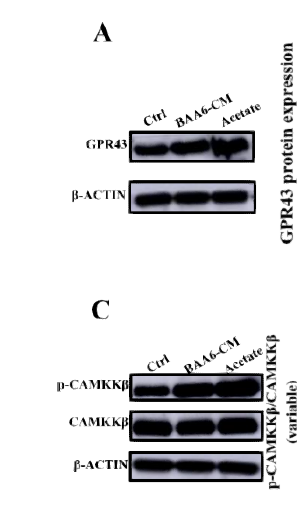CaMKK2 (Phospho Ser511) rabbit pAb
- Catalog No.:YP1285
- Applications:WB
- Reactivity:Human;Mouse;Rat
- Target:
- CaMKK2
- Fields:
- >>Autophagy - animal;>>AMPK signaling pathway;>>Longevity regulating pathway;>>Adipocytokine signaling pathway;>>Oxytocin signaling pathway;>>Alcoholic liver disease;>>Alcoholism
- Gene Name:
- CAMKK2 CAMKKB KIAA0787
- Protein Name:
- CaMKK2 (Ser511)
- Human Gene Id:
- 10645
- Human Swiss Prot No:
- Q96RR4
- Mouse Gene Id:
- 207565
- Mouse Swiss Prot No:
- Q8C078
- Rat Gene Id:
- 83506
- Rat Swiss Prot No:
- O88831
- Immunogen:
- Synthesized phosho peptide around human CaMKK2 (Ser511)
- Specificity:
- This antibody detects endogenous levels of Human Mouse Rat CaMKK2 (phospho-Ser511)
- Formulation:
- Liquid in PBS containing 50% glycerol, 0.5% BSA and 0.02% sodium azide.
- Source:
- Polyclonal, Rabbit,IgG
- Dilution:
- WB 1:1000-2000
- Purification:
- The antibody was affinity-purified from rabbit serum by affinity-chromatography using specific immunogen.
- Concentration:
- 1 mg/ml
- Storage Stability:
- -15°C to -25°C/1 year(Do not lower than -25°C)
- Other Name:
- Calcium/calmodulin-dependent protein kinase kinase 2 (CaM-KK 2) (CaM-kinase kinase 2) (CaMKK 2) (EC 2.7.11.17) (Calcium/calmodulin-dependent protein kinase kinase beta) (CaM-KK beta) (CaM-kinase kinase beta) (CaMKK beta)
- Observed Band(KD):
- 65kD
- Background:
- The product of this gene belongs to the Serine/Threonine protein kinase family, and to the Ca(2+)/calmodulin-dependent protein kinase subfamily. The major isoform of this gene plays a role in the calcium/calmodulin-dependent (CaM) kinase cascade by phosphorylating the downstream kinases CaMK1 and CaMK4. Protein products of this gene also phosphorylate AMP-activated protein kinase (AMPK). This gene has its strongest expression in the brain and influences signalling cascades involved with learning and memory, neuronal differentiation and migration, neurite outgrowth, and synapse formation. Alternative splicing results in multiple transcript variants encoding distinct isoforms. The identified isoforms differ in their ability to undergo autophosphorylation and to phosphorylate downstream kinases. [provided by RefSeq, Jul 2012],
- Function:
- catalytic activity:ATP + a protein = ADP + a phosphoprotein.,domain:The autoinhibitory domain overlaps with the calmodulin binding region and may be involved in intrasteric autoinhibition.,domain:The RP domain (arginine/proline-rich) is involved in the recognition of CAMKI and CAMK4 as substrates.,enzyme regulation:Activated by Ca(2+)/calmodulin. Binding of calmodulin may releave intrasteric autoinhibition. Autophosphorylation does not alter activity or regulation by Ca(2+)/calmodulin. In part, activity is independent on Ca(2+)/calmodulin.,function:Calcium/calmodulin-dependent protein kinase belonging to a proposed calcium-triggered signaling cascade involved in a number of cellular processes. Isoform 1, isoform 2 and isoform 3 phosphorylate CAMK1 and CAMK4. Isoform 3 phosphorylates CAMK1D. Isoform 4, isoform 5 and isoform 6 lacking part of the calmodulin-binding domain are inactive. See
- Subcellular Location:
- Nucleus . Cytoplasm . Cell projection, neuron projection . Predominantly nuclear in unstimulated cells, relocalizes into cytoplasm and neurites after forskolin induction. .
- Expression:
- Ubiquitously expressed with higher levels in the brain. Intermediate levels are detected in spleen, prostate, thyroid and leukocytes. The lowest level is in lung.
Bifidobacterium animalis subsp. lactis A6 Enhances Fatty Acid β-Oxidation of Adipose Tissue to Ameliorate the Development of Obesity in Mice Nutrients. 2022 Jan;14(3):598. WB Mouse epididymal adipose tissues
- June 19-2018
- WESTERN IMMUNOBLOTTING PROTOCOL
- June 19-2018
- IMMUNOHISTOCHEMISTRY-PARAFFIN PROTOCOL
- June 19-2018
- IMMUNOFLUORESCENCE PROTOCOL
- September 08-2020
- FLOW-CYTOMEYRT-PROTOCOL
- May 20-2022
- Cell-Based ELISA│解您多样本WB检测之困扰
- July 13-2018
- CELL-BASED-ELISA-PROTOCOL-FOR-ACETYL-PROTEIN
- July 13-2018
- CELL-BASED-ELISA-PROTOCOL-FOR-PHOSPHO-PROTEIN
- July 13-2018
- Antibody-FAQs
- Products Images

- Bifidobacterium animalis subsp. lactis A6 Enhances Fatty Acid β-Oxidation of Adipose Tissue to Ameliorate the Development of Obesity in Mice Nutrients. 2022 Jan;14(3):598. WB Mouse epididymal adipose tissues



